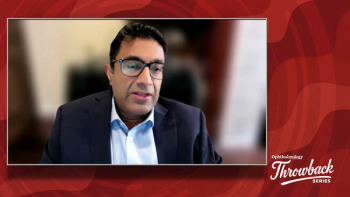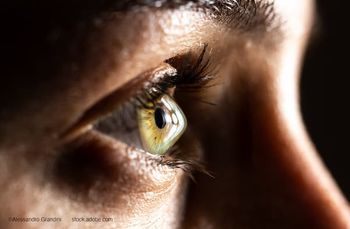
‘Super formula’ maximizes accuracy for IOL powers
An IOL “super formula” may broaden the conceptual understanding of IOL calculations, improve clinical outcomes for patients, and stimulate further progress in IOL formula research.
Take-home message: An IOL “super formula” may broaden the conceptual understanding of IOL calculations, improve clinical outcomes for patients, and stimulate further progress in IOL formula research.
Reviewed by John G. Ladas, MD, PhD
Baltimore-A novel method has been developed that visualizes three-dimensional IOL formulas.
Referred to as the “super formula,” the Ladas Super Formula is comprised of the ideal segments taken from five of the existing IOL formulas currently used and uses the ideal IOL formula for individual eyes, said John G. Ladas, MD, PhD.
The investigators who developed this method hope that it will fulfill three goals: “broaden the conceptual understanding of IOL calculations, improve clinical outcomes for patients, and stimulate further progress in IOL formula research.”
Surgeons can attest to the fact that calculating the appropriate IOL power for individual patients can be difficult.
However, undertaking the task is important to obtain the best vision possible postoperatively, said Dr. Ladas, assistant professor of ophthalmology, Wilmer Eye Institute, Johns Hopkins University School of Medicine, Baltimore.
As Dr. Ladas and colleagues pointed out, in general, all of the existing IOL formulas are highly accurate in predicting which IOL should be used for certain refractions.
“However,” they noted, “certain formulas have been found to be more accurate under specific conditions related to the input variables that are used, such as axial length and corneal power, which is likely related to the different ways the formulas use these data to determine the theoretical effective lens position based on the input data.”
However, the rub is that no one formula performs perfectly in all situations, surgeons must then make an educated guess about which formula to use.
Working with Albert Jun, MD, PhD, Aazim Siddiqui, MD, and Uday Devgan, MD, they developed a method to represent IOL calculations in three dimensions. This methodology uses the most accurate and current information on IOL formulas, adjustments, and lens design to create one “super surface” leading to the development of an IOL super formula.
The existing formulas that were included in their initial study were the Hoffer Q, Holladay I, Holladay I with Koch adjustment, Haigis, and SRK/T. The investigators then determined at what point the IOL powers calculated using those formula differed by more than 0.5 D, 1.0 D, and 1.5 D from each of the other formulas. A super surface was created that included the ideal portions from four of the five formulas to generate the super formula.
The IOL powers from 100 consecutive eyes of 100 patients then were calculated using the five formulas and the super formula. The main outcomes measures were the IOL powers and the degree of disagreement between a currently used IOL formula and the new super formula. The authors published their findings in JAMA Ophthalmol. doi:10.1001/jamaophthalmol.2015.3832.
Literature review
Based on a literature review, the authors used the Hoffer Q formula for eyes with an axial length of 21.49 mm or shorter, the Holladay I formula with the Koch adjustment for those with an axial length exceeding 25 mm, the Haigis formula when a negatively powered IOL was needed, and, the Holladay I formula for all others.
“Although the existing formulas gave similar results over a range of input parameters, they also diverged significantly at specified ranges of input parameters,” the authors said. “This divergence results in clinical dilemmas for surgeons and potential suboptimal results for patients.”
The authors found that all formulas differed from at least one of the other four formulas by more than 0.5 D over the range of parameters.
“When the tolerance for divergence between formulas is increased to 1.0 D in predicted IOL power (a clinically undesirable level), there are areas of correspondence between all formulas tested, which increase further when tolerance is raised to 1.5 D," the study reported. "Thus, resolving these areas of discrepancy is of high clinical relevance.”
When they included the most accurate output portions of each IOL formula in a combined super formula, they found stepwise development and evolution of a singular multifaceted surface, including the most accurate portions of multiple individual formulas based on specified ranges of input variables.
At this point, they tested the super formula in the 100 study eyes and reported that “the super formula localized to the correct portion of the super surface 100% of the time and thus chose the most appropriate IOL power value."
Power results
The individual formulas deviated from the optimal super formula IOL power values by more than 0.5 D 30% of the time in Hoffer Q, 16% in Holladay I, 22% in Holladay I with Koch adjustment, 48% in Haigis, and 24% in SRK/T. The individual formulas deviated from the optimal super formula IOL power values by more than 1.0 D 12% of the time in Hoffer Q, 5% in Holladay I, 2% in Holladay I with Koch adjustment, 8% in Haigis, and 1% in SRK/T.”
Dr. Ladas and colleagues emphasized that the results show how often there is clinical disparity in the IOL powers determined by the currently used IOL formulas. The hope is that their method can broaden the conceptual understanding of IOL calculations, improve clinical outcomes for patients, and stimulate further progress in IOL formula research.
More information on this methodology can be found at
John G. Ladas, MD, PhD
The authors have an ownership interest in the Ladas Super Formula and Ladas Super Surface and associated methodologies and processes.
Newsletter
Don’t miss out—get Ophthalmology Times updates on the latest clinical advancements and expert interviews, straight to your inbox.



















































.png)


